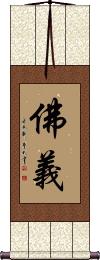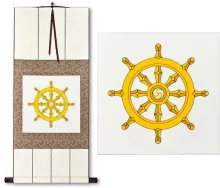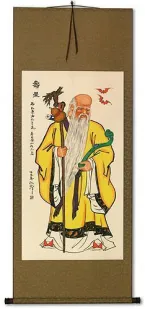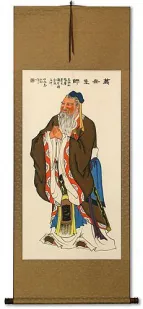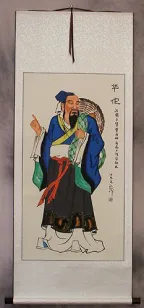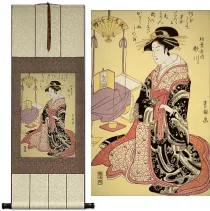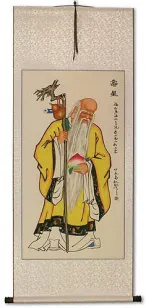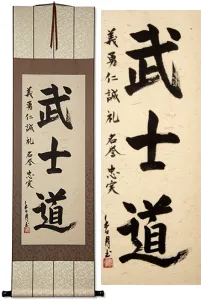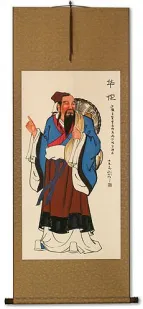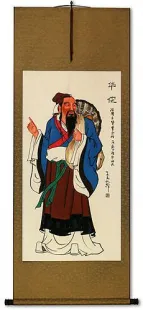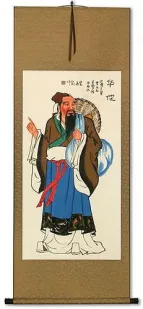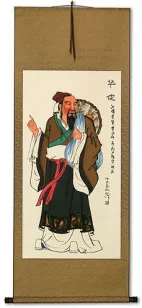Many custom options...
And formats...

Not what you want?
Try other similar-meaning words, fewer words, or just one word.
Feel free to email me with your request. If it's easy, I'll translate it for free and add it to this database of calligraphy for you.
The Principles of Buddhism in Chinese / Japanese...
Buy a The Principles of Buddhism calligraphy wall scroll here!
The Principles of Buddhism
In short, 佛義 is the Principles of Buddhism, but there is more (especially for the second character):
佛 is the character for the Buddha and Buddhism.
義 has deeper meanings including justice, righteousness, morality, honour/honor, teachings, doctrine, right, proper, righteous, loyalty, purpose, or meaning. So the single word “principles” is often used to encompass all these ideas.
This in-stock artwork might be what you are looking for, and ships right away...
The Physician of Ancient China
Wall Scroll
Discounted Blemished
Gallery Price: $67.00
Your Price: $37.00
Gallery Price: $108.00
Your Price: $59.88
Gallery Price: $200.00
Your Price: $79.88
Gallery Price: $200.00
Your Price: $118.88
Gallery Price: $72.00
Your Price: $39.88
Gallery Price: $200.00
Your Price: $79.88
Gallery Price: $200.00
Your Price: $79.88
Gallery Price: $200.00
Your Price: $79.88
Gallery Price: $200.00
Your Price: $79.88
Not the results for The Principles of Buddhism that you were looking for?
Below are some entries from our dictionary that may match your The Principles of Buddhism search...
| Characters If shown, 2nd row is Simp. Chinese |
Pronunciation Romanization |
Simple Dictionary Definition |
佛法 see styles |
fó fǎ fo2 fa3 fo fa buppō |
More info & calligraphy: Dharma / Buddhist Doctrinebuddhadharma; the Dharma or Law preached by the Buddha, the principles underlying these teachings, the truth attained by him, its embodiment in his being. Buddhism. |
宗 see styles |
zōng zong1 tsung motoi もとい |
school; sect; purpose; model; ancestor; clan; to take as one's model (in academic or artistic work); classifier for batches, items, cases (medical or legal), reservoirs (1) (rare) origin; source; (2) (rare) virtuous ancestor; (given name) Motoi Ancestors, ancestral; clan; class, category. kind; school, sect; siddhānta, summary, main doctrine, syllogism, proposition, conclusion, realization. Sects are of two kinds: (1) those founded on principles having historic continuity, as the twenty sects of the Hīnayāna, the thirteen sects of China, and the fourteen sects of Japan: (2) those arising from an individual interpretation of the general teaching of Buddhism, as the sub-sects founded by Yongming 永明 (d. 975), 法相宗, 法性宗, 破相宗, or those based on a peculiar interpretation of one of the recognized sects, as the Jōdo-shinshū 淨土眞宗 found by Shinran-shōnin. There are also divisions of five, six, and ten, which have reference to specific doctrinal differences. Cf. 宗派. |
佛宗 see styles |
fó zōng fo2 zong1 fo tsung busshū |
Buddhism; principles of the Buddha Law, or dharma. |
大綱 大纲 see styles |
dà gāng da4 gang1 ta kang ootsuna おおつな |
synopsis; outline; program; leading principles (1) fundamental principles; main lines; (2) outline; summary; general features; (place-name, surname) Ootsuna The main principles of Buddhism, likened to the great ropes of a net. |
思慧 see styles |
sī huì si1 hui4 ssu hui shie |
The wisdom attained by meditating (on the principles and doctrines of Buddhism). |
玄宗 see styles |
xuán zōng xuan2 zong1 hsüan tsung gensou / genso げんそう |
(person) Xuanzong (Emperor of China, r. 712-756) The profound principles, or propositions, i. e. Buddhism. |
道理 see styles |
dào li dao4 li5 tao li michitada みちただ |
reason; argument; sense; principle; basis; justification; CL:個|个[ge4] reason; logic; sense; truth; right; (given name) Michitada Truth, doctrine, principle; the principles of Buddhism, Taoism, etc. |
瑜伽宗 see styles |
yú jiā zōng yu2 jia1 zong1 yü chia tsung Yuga Shū |
see 唯識宗|唯识宗[Wei2 shi2 zong1] The Yogācāra, Vijñānavāda, Tantric, or esoteric sect. The principles of Yoga are accredited to Patañjali in the second century B.C., later founded as a school in Buddhism by Asaṅga, fourth century A.D. Cf. 大教. Xuanzang became a disciple and advocate of this school. [Note: The information given above by Soothill and Hodous contains serious errors. Please see this entry in the Digital Dictionary of Buddhism for correction.] |
阿梨耶 see styles |
ā lí yé a1 li2 ye2 a li yeh ariya |
ārya, 阿利宜; 阿棃宜; 阿黎宜; 阿犁宜; 阿離宜; 阿哩夜; 阿略 or 阿夷; 梨耶 loyal, honourable, noble, āryan, 'a man who has thought on the four chief principles of Buddhism and lives according to them,' intp. by 尊 honourable, and 聖 sage, wise, saintly, sacred. Also, ulūka, an owl. |
The following table may be helpful for those studying Chinese or Japanese...
| Title | Characters | Romaji (Romanized Japanese) | Various forms of Romanized Chinese | |
| The Principles of Buddhism | 佛義 佛义 | butsu gi / butsugi | fó yì / fo2 yi4 / fo yi / foyi | fo i / foi |
| In some entries above you will see that characters have different versions above and below a line. In these cases, the characters above the line are Traditional Chinese, while the ones below are Simplified Chinese. | ||||
Successful Chinese Character and Japanese Kanji calligraphy searches within the last few hours...
